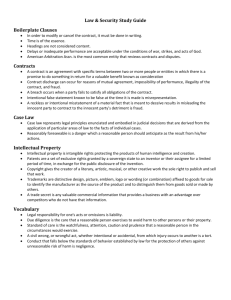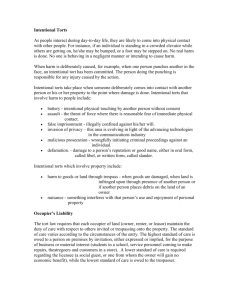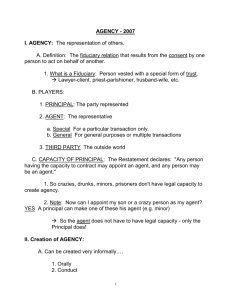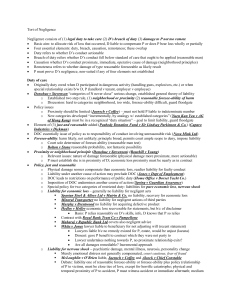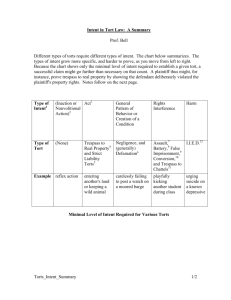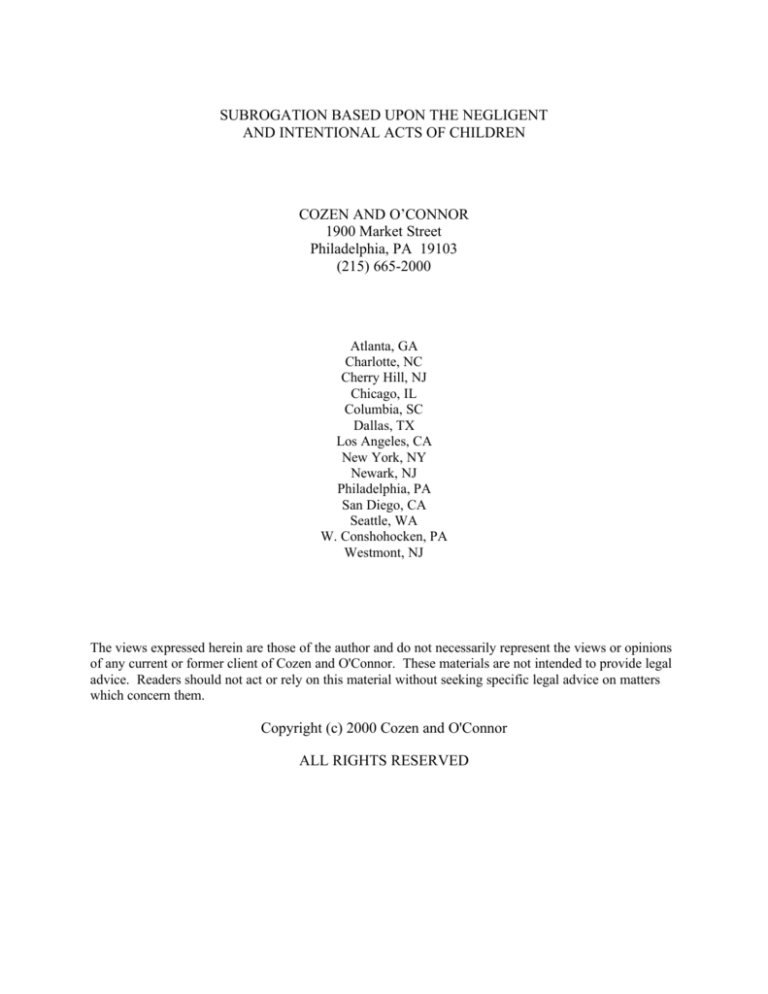
SUBROGATION BASED UPON THE NEGLIGENT
AND INTENTIONAL ACTS OF CHILDREN
COZEN AND O’CONNOR
1900 Market Street
Philadelphia, PA 19103
(215) 665-2000
Atlanta, GA
Charlotte, NC
Cherry Hill, NJ
Chicago, IL
Columbia, SC
Dallas, TX
Los Angeles, CA
New York, NY
Newark, NJ
Philadelphia, PA
San Diego, CA
Seattle, WA
W. Conshohocken, PA
Westmont, NJ
The views expressed herein are those of the author and do not necessarily represent the views or opinions
of any current or former client of Cozen and O'Connor. These materials are not intended to provide legal
advice. Readers should not act or rely on this material without seeking specific legal advice on matters
which concern them.
Copyright (c) 2000 Cozen and O'Connor
ALL RIGHTS RESERVED
I.
Introduction
These materials attempt to explain how to proceed in a subrogation action for the
negligent and/ or intentional acts of children. the first section explains the various theories of
liability used in this area and the second section addresses the coverage issues presented by this
topic.
II.
Theories of Liability
There are four basic theories of liability one may use when pursuing subrogation
based upon the acts of children. Claims maybe made against children both for negligence and
for intentional torts and claims may be made against the parents under theories of vicarious and
negligent entrustment or supervision.
A.
Negligence
Generally, children are liable for their negligent acts and omissions. Negligence
consists of four elements:
(1)
Duty of reasonable care;
(2)
Breach of duty;
(3)
Proximate cause; and
(4)
Damages
Issues with regard or not a duty exists are substantially similar to cases involving
the liability of adults. The more difficult question involves which standard of care is to be
applied.
Generally, children are not held to an adult standard of care. The Washington
Pattern Jury Instruction defines the duty of a child as follows:
In considering the claimed negligence of a child, you are instructed that it is the duty of a child to
exercise the same care that a reasonably careful child of the same age, intelligence, maturity,
training and experience would exercise under the same or similar circumstances.
See WP1 10.05
Historically, courts applied the “tender years doctrine” which was basically a
presumption that children between seven and fourteen years of age were incapable of negligence.
This presumption could be rebutted upon a showing that the child was fully aware of the
injurious consequences that could result from a negligent act. The old view held that children
under the age of seven were not capable of negligence and therefore not subject to liability for
their negligent acts.
PHILA1\289177\1 099995.000
03/28/00 3:52:00 pm
-2-
Currently, most states hold that children of very young years, three and under, are
simply incapable of negligence. Between three and six, the matter is very difficult and would
depend upon the age and intelligence of the child. Most Washington decisions address the
different but similar issue of whether a child is contributorily negligent for her own injuries.
These cases apply to the issue of the standard of care a child owes to others by analogy. The
Washington Supreme Court has held that a four-year-old child is not capable of contributory
negligence as a matter of law. See Arnold v. Laird, 94 Wn.2d 867, 621 P.2d 138 (1980). A
more recent Washington decision held that a child under six cannot be contributory negligent as
a matter of law and that the contributory negligence of minors between the ages of six and
sixteen is a question of fact. See Bauman v. Chapman v. Crawford, 104 Wn. 2d 241, 704 P.2d
1181 (1985).
In Oregon, there is a special negligence rule regarding children’s liability which
absolves them of fault if they act reasonably, given their age, intelligence and experience. See
Thomas v. Inman, 282, Or. 279, 578 P.2d 399 (1978). This is very similar to the Washington
Pattern Jury Instruction on the standard of care for children.
An exception to the rule set forth in WP1 10.05 is for inherently dangerous
activities. When a child drives a motor vehicle such as a boat, jet ski, snowmobile, motorcycle,
car or uses a weapon of some type, that child will generally be held to an adult standard of care.
This rule is applied in virtually all jurisdictions.
In Robinson v. Lindsay, 92 Wn.2d 410, 598 P.2d 392 (1979), Billy Anderson,
(13) was driving a snowmobile with Kelly Robinson, (11) seated on the rear. Following a crash,
Kelly lost use of her thumb and sued Billy and his parents. The trial verdict was for the
defendant and an appeal followed. At trial, WP1 10.05, quoted above, was given to the jury.
The Supreme Court reversed and held that when a child engages in an inherently dangerous
activity, he or she should be held to an adult standard of care.
B.
Intentional Acts
If an infant commit(sic) an assault, or utter slander, God forbid that he should not
be answerable for it in a court of justice.
See Jennings v. Rundall, 8 T.R. 335, 101 Eng. Rep. 1419 (1979)
The general rule is that children are liable for theirintentional torts. A commentor
states:
Ordinarily, tort liability attaches regardless of age where the nature of the act is
such that children of a like age would realize its injurious consequences.
See 42 AM. Jur. 2d, infants, § 141.
However, as in the negligence situation, very young children are oftentimes held
incapable of forming the requisite intent that is an element of the tort.
PHILA1\289177\1 099995.000
03/28/00 3:52:00 pm
-3-
For example, in a Connecticut case, Sharon (5) threw a rock at Michael (8),
causing a laceration over his right eye. It turns out that Michael deserved getting hit with the
rock because he was trying to run Sharon over with his bike. The tort alleged required proof of
malicious intent. The Connecticut Circuit Court held that Sharon was incapable of forming the
intent to harm Michael and therefore was not guilty of the tort. The court stated:
Where a tort requires a particular state of mind, and an infant because of his age
or mental capacity, is incapable of forming such state of mind, he cannot be found guilty of the
tort. Accordingly, although an infant of quite tender years may be held liable where the only
intention necessary to the commission of the tort is the intention to perform the physical act in
question...such an infant cannot be held liable where malice is the gist of the tort and he is too
young to formulate the necessary malicious intention....
See Walker v. Kelly, 6 Conn. Cir. 715, 314 A.2d 785(1973).
In an Oregon case involving a trespass, the Court of Appeals stated that “the age
of tortfeasors in intentional trespass is relevant only to the question of their ability to form the
necessary intent to do the act which is a trespass.” See Gymnastics USA v. McDougal, 92 Or.
App. 453, 758 P.2d 881 (Or. App. 1988).
While the child’s age is relevant to show that he could not form an adequate intent
to touch, offend or harm, many cases have held very young children liable for their tortious acts.
In Ellis v. D’Angelo, 116 Ca. App. 2d 310, 253 P.2d 675 (1953), a four-year-old child was found
capable of intending the violent and harmful striking of another.
Perhaps the most famous commentator on torts states:
Infants are held liable for assault and battery, trespass to land, conversion,
defamation, seduction, deceit and negligence.
See Prosser, Torts (4th Ed.) at p. 996.
A Washington court addressed this issue and held that a five-year-old boy could
be held liable for intentional harm to an adult when he pulled a chair out from under here as she
began to sit down. See Garratt v. Dailey, 46 Wn. 2d 197, 279 P.2d 1091 (1955). However, on a
second appeal following a second trial, the court held that Brian did not intend to harm Ruth
Garratt, and therefore he would not be liable for this act.
C.
Parental Liability Under Statutory Law
The difficulty with suing children is that they generally have no assets to satisfy a
judgment. However, a Washington statute subjects parents to liability for wilful or malicious
injuries to persons or property by their children. RCW 4.24.190 states:
The parent or parents of any minor child under the age of eighteen years who is
living with the parent or parents and who shall wilfully or maliciously destroy property, real or
personal or mixed, or who shall wilfully and maliciously inflict persona injury on another person,
shall be liable to the owner of such property or to the person injured in a civil action at law for
PHILA1\289177\1 099995.000
03/28/00 3:52:00 pm
-4-
damages in an amount not to exceed $5,000.00. This section shall in no way limit the amount of
recovery against the parent or parents for their own common law negligence.
Oregon has a similar statute, O.R.S. 30.765, which states, in part:
(1)
In addition to any other remedy provided by law, the parent or parents of
an unemancipated minor child shall be liable for actual damages to person
or property caused by any tort intentionally or recklessly committed by
such child...
(2)
The legal obligation of the parent...shall be limited to not more than
$7,500.
While the section below addresses coverage issues, it is important to note that
when pleading an intentional tort as opposed to an action founded in negligence, recovery
against the parents in Washington will be limited to $5,000, and to $7,500 in Oregon assuming
there is no alternative theory of liability against the parents.
D.
Vicarious Liability of Parents
Generally, a master is responsible for the acts of his servant. For example, if
parents send their child to the store in the parents’ vehicle to pick up groceries and the child gets
in an accident due to his or her own negligence, the parents may be vicariously liable.
In an early Missouri case, a father directed his sons to remove trespassing cattle
from his lands. The sons used dogs to round up the cattle, which caused a stampede and injured
several of the cattle. The court held the parents liable for the acts of their children. See Schmidt
v. Adams, 18 Mo. App. 432 (1885).
In another decision, the defendants’ thirteen-year-old son started a trash fire in the
front yard. The plaintiff was a five-year-old child who was burned by the fire. The defendants
were held liable for the actions of their son in allowing the five year-old child to come in contact
with the flames. See Cox v. Hugo, 329 P.2d 467 (Wash. 1958).
E.
Negligent Supervision and Negligent Entrustment
Where a parent has knowledge of the vicious or destructive tendencies of the
child, and fails to exercise reasonable measures to control the child, the parent is generally liable
for the acts of the child. Parents may also be liable if they entrust the child with an
instrumentality which is dangerous, or which, because of the youth or inexperience of the child,
may become a source of danger to others.
In an early Washington case, the defendants~ child struck the five-year-old
plaintiff in the eye with a stick. The parents knew of the child’s habit of striking children with
sticks. The father made no effort to restrain the child, and therefore the court imposed liability.
See, Norton v. Payne, 154 Wn. 241, 281 P.991 (1929).
PHILA1\289177\1 099995.000
03/28/00 3:52:00 pm
-5-
In a more recent Connecticut decision, the defendants’ four-year-old child stuffed
papers into the trousers of the two-and-one-half year old plaintiff and lit them on fire. This
caused severe burns to the plaintiff, resulting in the lawsuit against the four-year-old~s parents.
The defendant mother testified that her son was “fascinated by fire” and she “did not know what
she was going to do about it”. Based upon this testimony, the four-year-old’s parents were held
liable for the injuries to the plaintiff. See Jarboe v. Edwards, 223 A.2d 402 (Conn. 1996).
(i)
When Does a Parent Have Knowledge of a Child’s Dangerous
Proclivity?
In a recent decision, the Washington State Court of Appeals addressed the issue of
how closely the prior behavior of a child must resemble the tortious behavior complained of a
result in parental liability under a theory of negligent supervision. Young Art Pacheco was in the
habit of playing Ninja warrior, which involved dressing up in a Ninja outfit armed with throwing
stars, knives and guns. In the six months preceding the shooting of the police officer, young Art
committed three second-degree burglaries, several acts of vandalism and had been convicted of
attempted theft. At the time of the shooting, Art owned two .22-caliber rifles, a pellet gun and a
BB rifle. When they learned of Art’s burglaries and vandalism, Art’s parents imposed severe
restrictions on him. One of these restrictions involved tying up Arthur and putting him into a bed
with Father, Rudolph, to prevent him from leaving the house. However, young Art avoided this
on most occasions and was successful in sneaking out through a window several times dressed in
his Ninja outfits. Art’s parents sough psychological counseling for him after he was arrested for
the burglaries and were informed by his therapist and the school’s vice principal that Art was
doing much better in school. However, on May 21, 1987, young Art dressed up in a Ninja outfit
and shot Robert Barrett, a police officer, while committing a burglary at a middle school in
Lynnwood.
The police searched Art’s room after the burglary and found a pipe bomb, two
large incendiary devices, .22-caliber ammunition rounds, shotgun shells and substances used in
making explosives and various Ninja weapons. The officers also found a book and computer
print-outs on how to make black powder, pipe bombs and other explosives.
The police officer sued Art’s parents for negligent supervision. The court set
forth the standard for liability under this doctrine as follows:
Under the doctrine of negligent supervision, parents are liable for the intentional torts of their
minor children when: (a) the child has a dangerous proclivity; (b) the parents know of the child’s
dangerous proclivity; (c) they fail to exercise reasonable care in controlling that proclivity.
The trial court granted summary judgment to Art’s parents, holding that the
parents did not know about their son’s dangerous proclivity. The Court of Appeals affirmed this
decision, stating:
In the present case, while Arthur had committed prior delinquent acts, none of
them was of the same or similar nature as the shooting of Barrett. The three burglaries Arthur
committed several months before the shooting involved a school and two vacant homes. His
other crimes, attempted theft and vandalism, were also property crimes. Significantly, there is no
evidence Arthur was armed with any type of weapon when he committed any of the prior
PHILA1\289177\1 099995.000
03/28/00 3:52:00 pm
-6-
crimes...Arthur’s prior delinquent behavior did not manifest a dangerous tendency to commit the
violent assault against Barrett. Put another way, Arthur’s prior crimes were not within the same
zone of behavior that would put a reasonable parent on notice that his or her child might commit
the tort or crime that injured the victim.
See Barrett v. Pacheco, 62 Wash. App. 117, 815 P.2d 834 (Wash. App. 1991)
(emphasis added).
(ii)
What Constitutes “Reasonable Supervision”?
It is neither customary nor practicable for parents to follow children around with a
keeper, or chain them to a bedpost.
W. Prosser, Law of Torts §59 (3rd Ed. 1964)
In another Washington decision, two four-and-one-half year old children were
playing with matches and cigarettes when young Bert’s shirt caught fire and he sustained severe
burns and injuries. The incident occurred in the side yard of Bert’s home while his mother was
inside the house reading or sleeping. Bert’s friend, Jeremy, was spending his days at the home of
his grandparents who lived across the street.
At the time of the incident, Jeremy was not permitted to play at Bert’s house
because of previous incidents involving burns, cigarettes and alleged beer drinking. The two
children differed in their testimony as to who provided the matches. Just prior to the accident,
Jeremy’s grandfather showed Jeremy and several children how to fill their squirt guns from the
outdoor faucet. The grandfather returned inside the house to continue performing light
housekeeping chores. Fifteen to twenty minutes later, Bert was burned.
Bert brought suit against Jeremy’s mother and grandparents. The claim was
based upon the theory of negligent supervision and negligent entrustment for failing to supervise
Jeremy and for providing him matches. According to the Complaint, Jeremy had previously
displayed a propensity to acting recklessly with matches and a cigarette lighter, and that neither
his mother nor his grandparents exercised proper control under the circumstances.
The trial court dismissed the claims under the doctrine of parental immunity. The
court of appeals held that the doctrine of parental immunity did not apply, but that the claims
should have been dismissed in any event because there was no question of fact with regard to
whether or not Jeremy’s grandfather exercised reasonable care. When addressing the measure of
the duty owed to supervise one’s child, the court analogize to the responsibility one has for the
care of one’s own child. The court stated that:
One who voluntarily assumes responsibility for the care of a child has a duty to
exercise reasonable care to protect that child...The measure of the duty owed is determined by
what a reasonable person would do in the same circumstances.
See Carey v. Reeve, 56 Wash. App. 18, 781 P.2d 904 (Wash. App. 1989)
The court further stated:
PHILA1\289177\1 099995.000
03/28/00 3:52:00 pm
-7-
The law does not require that parents or custodians do the impossible for children,
“they are not required to watch them every minute”... Thus one with responsibility for a child’s
care “has no duty to foresee and guard against every possible hazard”, and will not be found to
have negligently supervised a child unless he or she “had some knowledge that the child was
frequenting a dangerous area, and failed to warn the child or take other adequate precautions.”
Id. 781 P.2d at 907-908. (citations omitted).
The Carey court found important the fact that Jeremy had never disobeyed his
grandfather before and had been forbidden to go to Bert’s house and that there was no indication
that Jeremy would disobey his grandfather.
Thankfully, the law does not require parents to maintain constant surveillance of
their children. To use the words of an old Louisiana court: “Parents are not required to restrain
their children within doors at their peril.” See Westerfield v. Levis Bros., 43 la. Ann. 63, 9 So.
52 (1890).
F.
Coverage Issues
Once you determine that a child or its parents are liable for property damage
under one of the theories set forth above, the issue then becomes whether the tortfeasor has any
assets to satisfy your judgment. Clearly, the most likely source of funds would be insurance
proceeds under the parent’s homeowner’s coverage. This section explains when coverage is
available for harm caused by children.
G.
Policy Language
Most homeowner’s policies provide that “insured” includes the named insured
and “residents of your household who are (a) your relatives, or (b) other persons under the age of
21 and in the care of any person named above.” As a result, there is generally coverage for the
negligent acts of children under the parent’s homeowner’s insurance policy. As always, the
harm must be caused by an “occurrence” and there must be no exclusions which apply.
The two issues which frequently arise in these cases are whether the incident was
an “occurrence” and whether or not the bodily injury or property damage was expected or
intended by the insured. Unfortunately, most decisions treat the issues as one and the same. In
essence, courts have buried the intentional acts exclusions inside the occurrence definitions,
thereby creating a confusing line of cases.
Each insurance policy must be closely examined because typical policy language
has been revised over time. However, “occurrence” has usually been defined as “an accident.”
The relevant exclusion usually states: “Personal liability and...medical payments to others do not
apply to “bodily injury” or “property damage” which is expected or intended by the “insured.”
H.
Judicial Interpretation - Washington
(1)
PHILA1\289177\1 099995.000
03/28/00 3:52:00 pm
Occurrence
-8-
The leading Washington case involving coverage for the negligent and/or
intentional acts of children under a homeowner’s policy is Unigard Mutual Ins. Co. v. Argonaut
Ins. Co., 20 Wn. App. 261, 579 P.2d 1015 (1978). In the Unigard case, young Willy Winkler
(11) broke into a school building and set fire to the contents of a trash can. He watched the fire
burn, then ran to a nearby water fountain to douse the blaze. He was unsuccessful and ran. He
did not notify anyone and the fire spread and caused significant damage to the school.
The school’s insurer sued both Willy and his parents, alleging negligence against
Willy and negligent supervision against his parents. Unigard brought a declaratory judgment
action seeking to avoid liability under the Winkler’s homeowner’s policy. The policy defined
“occurrence” as an accident which resulted in property damage and excluded property damage
which is “either expected or intended from the standpoint of the insured.”
In his deposition, Willy did a fine job of following the advice of the Argonaut
subrogation counsel and testified “I did not intend or expect to cause damage to the school
building.” However, he did state that he intended to light the fire in the first place. It also came
out that he know that fire could spread and that he had previously been involved in a fire-starting
venture.
The trial court held that no occurrence took place because no accidental fire could
result from a deliberate act. Argonaut argued on appeal that the term “accident” is ambiguous.
The appellate court held, “An accident is never present when a deliberate act is performed unless
some additional unexpected, independent and unforeseen happening occurs which produces or
brings about the injury.” The Unigard court stated further:
The means as well as the result must be unforeseen, involuntary, unexpected and unusual. The
intentional and deliberate act of William Winkler in starting the fire which caused the school
building blaze cannot be said to be involuntary. Therefore, there is no occurrence because the
fire damage to the building was the expected or intended result of a clearly intentional act.
As a result, Unigard had no duty to defend young Willy or to pay damages on his behalf. Id. 579
P.2d at 1018.
The Unigard case was decided under an Old HO-3 policy which used the term
“the insured” in the intentional acts exclusion rather than “an insured.” Therefore, the parents
were covered for the claim of negligent supervision because, under the old policy language, an
excluded act of one insured did not bar coverage for additional insureds who did not engage in
the intentional conduct.
The Unigard court based their decision upon the “occurrence” portion of the
policy. It is interesting to note that the Unigard court determined the fire was not an
“occurrence” for purposes of analyzing the child’s coverage and yet it was an “occurrence” for
purposes of extending coverage to the parents.
(2)
Intentional Acts Exclusion.
Other cases involving the actions of children address the intentional acts
exclusions. In general, to avoid coverage under this exclusion, it is necessary to establish that
PHILA1\289177\1 099995.000
03/28/00 3:52:00 pm
-9-
there was an intent to cause the injury or harm complained of. The intent may be inferred from
the nature of the act and the accompanying reasonable foreseeability of the harm. Once intent to
cause injury is found, it is immaterial that the actual injury caused is a different character or
magnitude than that intended.
In an Iowa case, an 11-year-old child threw a baseball at a friend and killed him.
Apparently, the 11-year-old was upset because he was not allowed to pitch during a workup
game. the court held that there was no intent to inflict bodily injury because the insurer failed to
established that the 11-year-old knew or should have known or expected that the friend’s death
would result from throwing a baseball at him. The exclusion at issue stated: “Personal liability
does not apply to bodily injury or property damage which is expected or intended by the
insured.” The court held that the exclusion is triggered where the insured intended both (1) to do
the act which caused the injury, and (2)
to cause some kind of bodily injury. The court
characterized the incident as a playground snit or mere bickering and determined that the 11year-old’s intent to hurt his friend did not rise to a level of intent to bodily injure him. See Amco
Ins. Co. v. Haht, 490 N.W. 2d 843 (Iowa 1992). It is important to note that there was a very
strong dissent in the Amco decision and one cannot help but wonder whether the court engaged
in a results-oriented analysis
(3)
Subjective vs. Objective Intent
Probably the most interesting question regarding the intentional acts exclusions
involves whether to focus on the actor’s subjective intent or to use an objection approach,
comparing the actions of the tortfeasor with the proverbial “reasonable person.”
In Rodriguez v. William, 107 Wn. 2d 381, 729 P.2d 627 (1986), a case involving
incest, the policy excluded coverage for bodily injury or property damage expected or intended
by the insured. The defendant’s affidavit stated that he did not subjectively intend to harm his
stepdaughter. Division 1 of the Court of Appeals defined “expected” as “more likely than not to
occur.” The appellate court held that a reasonable person would more likely than not expect
harm to occur as a result of the defendant’s actions involving sexual molestation and, therefore,
coverage was avoided under the intentional acts exclusions.
The Supreme Court rejected this reasonable person approach articulated by
Division 1 of the Court of Appeals. It focused on the specific language of the policy “expected
or intended by the insured.” it construed this as meaning that the insured must expect or intend
the harm.
Even though the Supreme Court used a subjective approach, it still held that there
was no coverage under the policy because this case involved incest. This holding was based on
the public policy reason that a person should not be able to purchase insurance for his immoral,
criminal or fraudulent acts.
In Diana v. Western Nat’l Assur. Co. 56 Wn. App. 741, 785 P.2d 479 (1990), the
Court of Appeals applied an objective standard stating: “All that is required is that the claimant
know or should know of facts from which a prudent person would conclude that the injurious
consequences are reasonably foreseeable.”
PHILA1\289177\1 099995.000
03/28/00 3:52:00 pm
- 10 -
Two recent cases in Washington fail to ultimately resolve the question as to
whether the court should use an objective or subjective analysis when addressing the intentional
act exclusion. In Safeco Ins. v. Butler, 118 Wn. 2d 383, 823 P.2d 499 (1992), Eddie Zenker used
firecrackers to blow up Hap Butler’s mailbox. Butler responded by grabbing two loaded
handguns, jumping in his car and chasing Zenker’s vehicle at high speed. Butler fired six shots
at Zenker’s truck, one of which ricocheted and hit Zenker in the head.
Safeco brought a declaratory judgment action arguing that there was no accident
and therefore no occurrence and that the intentional act exclusion applied. The court granted the
summary judgment motion in favor of Safeco but held that if there was bad faith in Safeco’s
handling of the claim, then they would be estopped from denying coverage.
The court appears to have used a subjective test in analyzing hap Butler’s actions.
Even though Hap Butler testified that he did not intend to shoot Eddie Zenker, the court
determined that given Butler’s experience and knowledge of guns, it was reasonably foreseeable
that a bullet shot toward Eddie Zenker could ricochet and cause him injury. In essence, based
upon Butler’s experience, the court inferred intent. Unfortunately, the lines between the
subjective versus objective analysis are blurred in the Butler decision. In fact, even though it
appeared to use a subjective analysis, the Butler court expressly rejects the subjective approach
toward determining whether or not an “occurrence” took place and states “[e]ither an incident is
an accident or it is not...The perspective of the insured as opposed to the tortfeasor is not a
relevant inquiry.”
The most recent case involving this issue is Queen City Farms v. Central Nat’l
Ins. 64 Wn. App. 838, 827 P.2d 1024 (1992). Queen City Farms addresses an environmental
coverage case wherein the CGL policy provided coverage for “[an] accident...which
unexpectedly and unintentionally results in...property damage...during the policy period.” The
QCF court used a subjective test in the words “accident” and “occurrence” were construed from
the standpoint of the insured. The QCF employees testified that they did not believe pollution
would occur as a result of their activities which included dumping waste into ponds and burning
them periodically to keep them from overflowing. The QCF court held that the language in the
coverage clause only precludes coverage if QCF subjectively expected and intended to cause the
groundwater pollution which occurred. However, the burden of proof as to QCF’s expectation
and intent is placed upon QCF.
The QCF court interprets the Butler decision as applying a subjective analysis to
Butler’s claim that the ricochet was unforeseen. The Butler court’s language regarding rejection
of the subjective theory was seen as only applying to the issue of whether Butler’s wife expected
or intended the harm. The Queen City Farms case is currently under appeal to the Washington
Supreme Court and a decision is expected shortly. Hopefully, this area will be cleared up by a
definitive ruling.
I.
Judicial Interpretation - Oregon
The law regarding subjective versus objective analysis is more clear in Oregon.
Oregon uses a subjective analysis. In Allstate Ins. Co. v. Browning, 598 F. Supp. 421 (U.S.D.C.
Or. 1983), Chris Browning (16) harassed a black family by burning a cross in their front yard
PHILA1\289177\1 099995.000
03/28/00 3:52:00 pm
- 11 -
and shouting racial epithets at them. The family sued Chris Browning for emotional distress and
other damages. Browning testified that he did not anticipate that the harm alleged would result
from his pranks and that he had not intent to harm the family.
The Allstate court held that the Oregon rule is that the harm itself, not just the act
causing the harm, must have been intended in order for the clause excluding liability for
intentionally causing injury or damage to apply. The Allstate court held that Chris Browning’s
acts were certain to cause a particular kind of harm and therefore it can be said that he intended
the harm. Therefore, there was no duty to defend under the policy.
In a similar case to the Rodriguez decision, the Oregon Court of Appeals
addressed a situation involving incest. The insured grandfather molested his granddaughter and
the trial court held that the defendant intentionally performed various acts of sexual molestation
over an extended period of time. Even though the grandfather testified that he had no subjective
intent to cause the emotional distress or physical injury, the court inferred the intent to cause
harm. See Mutual of Enumclaw v. Merrill, 102 Or. App. 408, 794 P.2d 818 (Or. App. 1990)
J.
In General
Unfortunately, there is no hard or fast rule or accurately predicting which specific
acts by children will be covered under a policy. Clearly, it is beneficial if the child testifies that
the act was accidental as opposed to intentional. However, under an objective theory this will
not be conclusive. Furthermore, as demonstrated above, even under a subjective standard, the
court may still infer intent as a matter of law.
Many times, a search through the law of other jurisdictions will reveal a set of
facts similar to those of your case. In City of Newtoon v. Krasnigor, 536 N.E. 2d 1078 (Mass.
1989), the court addressed a school fire wherein Eric Krasnigor and two friends broke into their
school and lit several fires. Eric testified that he did not specifically intend to cause substantial
damage to the school. However, his actions resulted in $1.3 million in property damage. The
court held that the intentional acts exclusions applied because the fires were deliberately set with
the intention of causing some property damage. Basically, the Krasnigor court inferred intent to
Eric Krasnigor. The court stated: “If there had been evidence that Krasnigor ‘started a fire’ for
warmth, or to guide his way through the darkness, or for any other motive, we might conclude
that the intent to cause some damage could not be inferred.” Id., 536 N.E. 2d at 1082.
In another case, a child who caused an injury by throwing firecrackers at another
child was covered under his parents’ homeowner’s coverage. See Morrill v. Gallagher, 370
Mich. 578, 122 N.W. 2d 687 (1963).
III.
Conclusion
Whether or not a child may be held liable for negligence depends upon the child’s
age and relative intelligence, maturity, training and experience. If a child engages in an activity
involving a dangerous instrumentality, he or she will be held to an adult standard of care. When
a child commits an assault or battery or some other type or intentional tort, many cases have held
very young children liable for those acts. However, if the tort requires proof of intent, a child’s
age may be relevant to show that the child is too young to formulate the necessary intention.
PHILA1\289177\1 099995.000
03/28/00 3:52:00 pm
- 12 -
Most states have statutes which subject parents to liability for wilful or malicious
injuries to persons or property committed by their children. However, the statutes generally limit
the parent’s liability.
Parents may also be held vicariously liable for the acts of their child when that
child is involved in an activity at the direction of the parent. In addition, parents may be liable
under a theory of negligent supervision or negligent entrustment. However, to be liable for
negligent supervision, a child must have a dangerous proclivity which is known of by the parents
and the parents must fail to exercise reasonable care in controlling that proclivity. No court has
imposed absolute liability on parents for the actions of their children.
Clearly, the most important issue in these cases involves whether or not there is
insurance coverage for the actions of the children. Under earlier policy language, even if a child
performed an intentional act, the parents usually were covered under their homeowner’s policy.
However, with the change in language from “the insured” to “an” or “any” insured, the focus is
now on the intent of the child. Washington courts are not yet clear whether the analysis of the
actor’s intent is subjective or objective. However, when the Queen City Farms case is decided,
the answer should be clear at least with respect to the CGL language. One may then argue by
analogy that a similar construction should be given to homeowner’s policy language. It is fairly
clear that Oregon courts utilize a subjective analysis. However, courts will usually closely
review the facts and will often infer intent if the harm is obviously foreseeable.
Successfully pursuing cases involving the acts of children clearly depends upon a
thorough investigation and early contact with the child to obtain a comprehensive statement
regarding the child’s intent in committing the act. Each case will present a unique set of facts
which must be compared against the policy language and the current law regarding the coverage
issues presented by this
[DocX971]
PHILA1\289177\1 099995.000
03/28/00 3:52:00 pm
- 13 -

